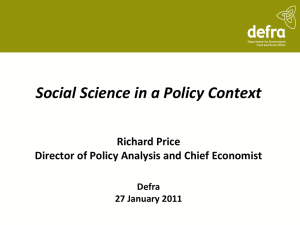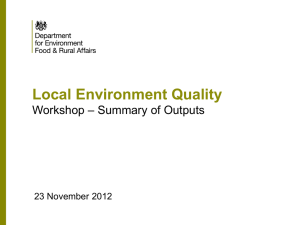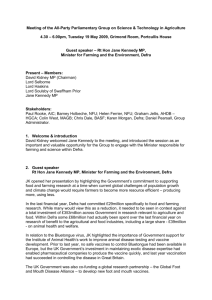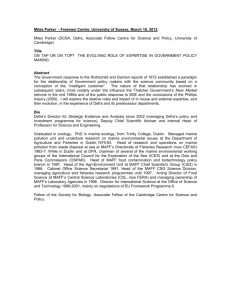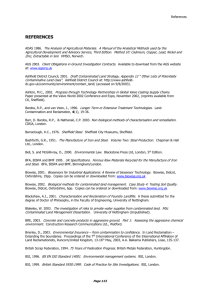C4SLs Background to CIEH Position Feb15
advertisement
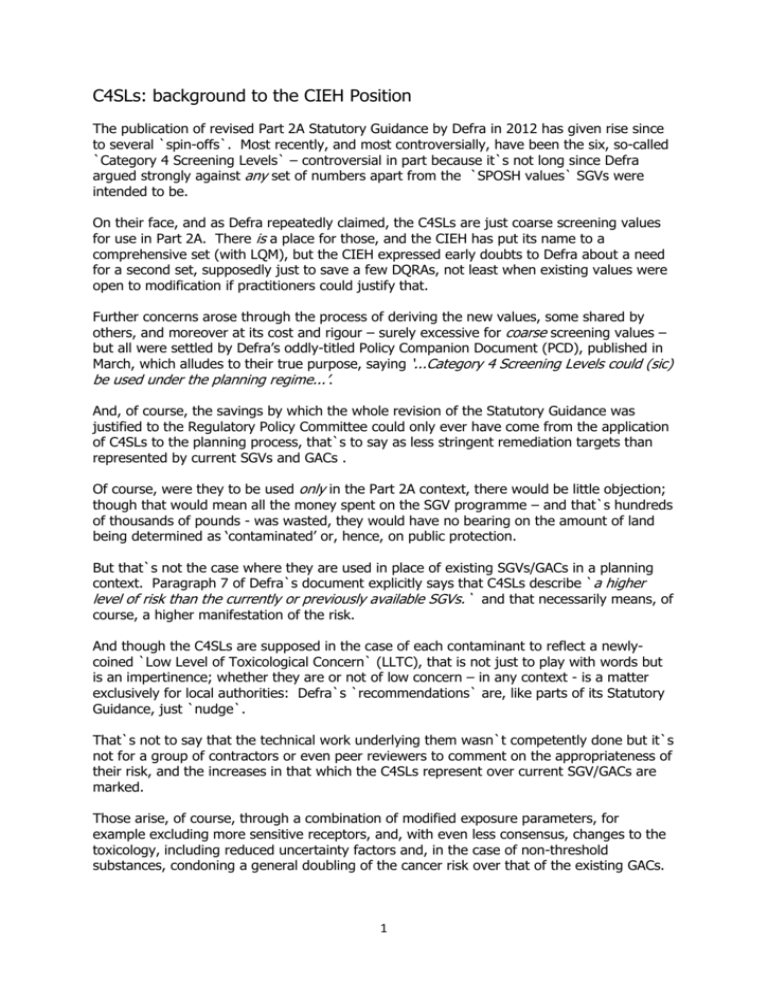
C4SLs: background to the CIEH Position The publication of revised Part 2A Statutory Guidance by Defra in 2012 has given rise since to several `spin-offs`. Most recently, and most controversially, have been the six, so-called `Category 4 Screening Levels` – controversial in part because it`s not long since Defra argued strongly against any set of numbers apart from the `SPOSH values` SGVs were intended to be. On their face, and as Defra repeatedly claimed, the C4SLs are just coarse screening values for use in Part 2A. There is a place for those, and the CIEH has put its name to a comprehensive set (with LQM), but the CIEH expressed early doubts to Defra about a need for a second set, supposedly just to save a few DQRAs, not least when existing values were open to modification if practitioners could justify that. Further concerns arose through the process of deriving the new values, some shared by others, and moreover at its cost and rigour – surely excessive for coarse screening values – but all were settled by Defra’s oddly-titled Policy Companion Document (PCD), published in March, which alludes to their true purpose, saying ‘...Category 4 Screening Levels could (sic) be used under the planning regime...’. And, of course, the savings by which the whole revision of the Statutory Guidance was justified to the Regulatory Policy Committee could only ever have come from the application of C4SLs to the planning process, that`s to say as less stringent remediation targets than represented by current SGVs and GACs . Of course, were they to be used only in the Part 2A context, there would be little objection; though that would mean all the money spent on the SGV programme – and that`s hundreds of thousands of pounds - was wasted, they would have no bearing on the amount of land being determined as ‘contaminated’ or, hence, on public protection. But that`s not the case where they are used in place of existing SGVs/GACs in a planning context. Paragraph 7 of Defra`s document explicitly says that C4SLs describe `a higher level of risk than the currently or previously available SGVs.` and that necessarily means, of course, a higher manifestation of the risk. And though the C4SLs are supposed in the case of each contaminant to reflect a newlycoined `Low Level of Toxicological Concern` (LLTC), that is not just to play with words but is an impertinence; whether they are or not of low concern – in any context - is a matter exclusively for local authorities: Defra`s `recommendations` are, like parts of its Statutory Guidance, just `nudge`. That`s not to say that the technical work underlying them wasn`t competently done but it`s not for a group of contractors or even peer reviewers to comment on the appropriateness of their risk, and the increases in that which the C4SLs represent over current SGV/GACs are marked. Those arise, of course, through a combination of modified exposure parameters, for example excluding more sensitive receptors, and, with even less consensus, changes to the toxicology, including reduced uncertainty factors and, in the case of non-threshold substances, condoning a general doubling of the cancer risk over that of the existing GACs. 1 More bizarrely, what represents LLTC also varies from one substance to another: in the cases of Arsenic, Benzene and BaP, Defra `recommends` accepting what it calls `Policy C4SLs` with even higher levels of risk `to avoid disproportionately targeting soil` in the light of current international standards for water and air quality. In the case of BaP this is to an ELCR of c.1 in 10,000. And if that is genuinely supposed to represent a coarse screening value under Pt2A, a SPOSH level must be significantly even less protective. Note that the project was not preceded by an informed public debate about the societal acceptance of risk and the CIEH does not agree that impacts of that order are of low concern. Only in the case of Lead is a C4SL proposed which is lower than the (withdrawn) SGV (and, interestingly, lower than common background levels) but, here again, Defra has chosen a value from the three put forward on the basis that the lowest was `considered to be too close to minimal risk to support its use in... the more pragmatic Category 4 Screening Levels`. Little better demonstrates Defra`s determination to engineer a gap between C4SLs and existing SGVs/GACs come what may. Not all of the project`s Steering Group seemed to be happy about it, para 8 of the PCD saying, tellingly, `The final report and this Policy Companion Document do not necessarily represent a collective view of the Group` and notwithstanding a cross-reference to the C4SLs inserted into National Planning Practice Guidance, the lack of their explicit endorsement nevertheless suggests DCLG is uneasy. Their sarcastic description of a `simple (sic) test` only adds to that suggestion. Nor was the project`s reception by the Committee on Toxicology as uncritical as reported – we know, because we had someone there - and a member of the CoT has raised continuing concerns since on Jiscmail. Public Health England too was part of the project steering group. It has said this: `PHE recognises the need for a pragmatic approach to contaminated land risk assessment. However, the final policy decisions lie with Defra, and Welsh Government in Wales.` and it is difficult not to read that as distancing PHE from Defra`s recommendations. Reinforcing that, they continue with this: “PHE recommends deriving a level of...minimal risk for non-threshold substances whenever possible...the overriding principle should be as low as reasonably practicable (ALARP). For non-threshold substances, the decision on an appropriate margin...applied to the point of departure, for example a factor of 5,000 (rather than a default of 10,000 for minimal risk) is a policy decision for Defra, or the local authority and is not based on scientific rationale. This may give a risk level higher than 1 in 100,000 (for example excess lifetime cancer risk). We would not generally support a lifetime excess cancer risk level higher than 1 in 10,000.” This matters, of course, in the planning context where, as it were, we`re remediating down to desired levels of risk and where, in general, there has so far been broad consensus about levels an order of magnitude lower. 2 But from exchanges on Jiscmail, it’s clear that people are confused about where they stand and, in particular, whether they now must accept C4SLs (or equivalents for other contaminants) if presented with them by developers. The argument (which the CIEH accepts is honestly made) runs something along the lines that, under planning, LPAs only need to be assured that, after remediation, (note, not as Defra`s PCD misquotes, after development) the land should not be capable of being Part 2A; once they show that there will be no unacceptable risks, the responsibility for securing the safe development of a site is the concern solely of developers. Since, then, Category 4 comprises land which, according to Defra`s definition, is definitely not `SPOSH`, and their C4SLs fall, they say, into Category 4, they cannot reflect unacceptable risks. Any land meeting them must therefore be `safe` and developers never need go further. While that is more about the interpretation of planning guidance than the appropriateness of a new set of GACs, we think that analysis is anyway mistaken. And as least one prominent practitioner wrote on Jiscmail in response, it would be against everyone`s expectations since at least the ICRCL days of the `70s. But our view starts, inevitably now, with the NPPF. Paragraph 109 of that, first of all, sets the direction of travel with an emphasis on enhancing the environment. Particularly pertinently, it makes separate references to preventing new development being adversely affected by unacceptable levels of soil pollution and to remediating contaminated land. The more familiar paragraphs, 120 and 121 continue that distinction, saying not only that `after remediation, as a minimum, land should not be capable of being…Pt 2A` but that, in addition, `the effects of pollution on health or general amenity should be taken into account.` Whereas the word `safe` was not in the draft NPPF but only added to the final version, that indicates that it means something in addition to `Part 2A-compliant` and, of course, para 121 acknowledges that with its words `as a minimum`. That also says, quite explicitly, that ensuring that a site is suitable for its new use, taking account of pollution arising from previous uses and any proposals for mitigation, is a task for planning policies and decisions. And while it really goes without saying that a site, once remediated, should not be capable of determination under Part 2A, that`s merely an inescapable cross-reference and it remains for each LPA to decide, in its reasonable view, taking account of the new use and other relevant considerations, how much residual risk to health or amenity from pollution it is prepared to accept for ever-after. That those risks may not precipitate SPOSH (itself a product of local discretion) does not automatically make them acceptable. And while developers may be responsible for delivery, para 120 does not give them the power to dictate what is acceptable (and neither can Defra or DCLG). If it did, the public interest role of LPAs would be redundant, replaced with one of mere rubber-stamping. 3 Underlying the different approaches are, of course, the different contexts of Part 2A and planning. Part 2A is about those who today find themselves on a suspect site (and as the statutory guidance says, making that suitable for its current use) whereas planning is about future generations, and it`s a mistake to regard `not unacceptable` in the context of Part 2A (when the relevant facts are relatively certain) as contiguous with `acceptable` in the context of planning. Given the continuing uncertainty about the toxicology of most contaminants (look, for example, at what has happened with Lead as we have learnt more about it), further uncertainties about the future occupation and use of land, and that there is no better opportunity than arises in the course of development to both apply and fund a better standard than Part 2A, the CIEH believes the case for LPAs to take a long-term, precautionary view and continue to look for `minimal` risk is fully justifiable. Hitherto, that has not been controversial. C4SLs produced to reduce remediation costs, and in particular those, as PHE noted, not based on science, do not, however, fulfil that role. They may still offer relatively long odds, but not long enough. Both developers and LPAs have favoured minimal risk in the past that`s not, as it has been misrepresented,`spotlessly clean`, nor in Defra`s phrase does it mean `digging up the whole of Cornwall`, or is it in conflict with para 206 of the NPPF on conditions - and in our view they should continue to do so. We note there is broad support for that from the majority of participants in the Jiscmail debate and from the construction world too where CIRIA`s recent Asbestos Guide says `It is appropriate that the planning process adopts a more stringent standard for levels of soil contamination than are relevant under Part 2A.` Further authority comes, if needed, from the National Planning Practice Guidance which (though it lacks the status of the NPPF) clearly distinguishes between `unacceptable levels under Part 2A` and `other considerations...that could affect the amenity of a site` of which it gives the example of contaminants. What should, then, be beyond dispute is that the setting of environmental standards is still a matter for LPAs and their Local Plans unless material considerations indicate otherwise in individual cases. While Local Plans have to have regard to the NPPF, that does not mandate particular standards and has not removed LPAs` discretion. Defra`s recommendations are neither material considerations nor, as someone suggested on Jiscmail, statutory guidance; they carry no more weight than contrary opinions and we believe LPAs can, if necessary, stand up in front of an Inspector and defend better standards of public health protection. That stance is neither anti-business or anti-growth but it`s about future health and wellbeing, social responsibility and environmental justice, and in line with the `Polluter Pays` principle. Developers with an eye on future liabilities, which care about their reputations and which want to give confidence to their purchasers have always understood that. It boils down to money vs public health; which side is the EIC on? _______ 4

